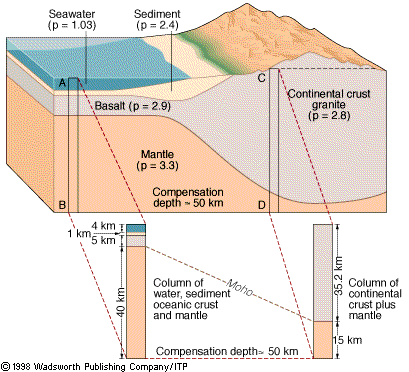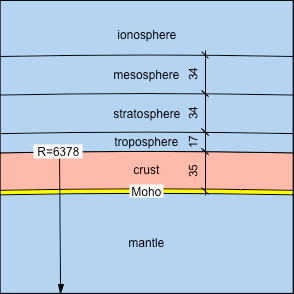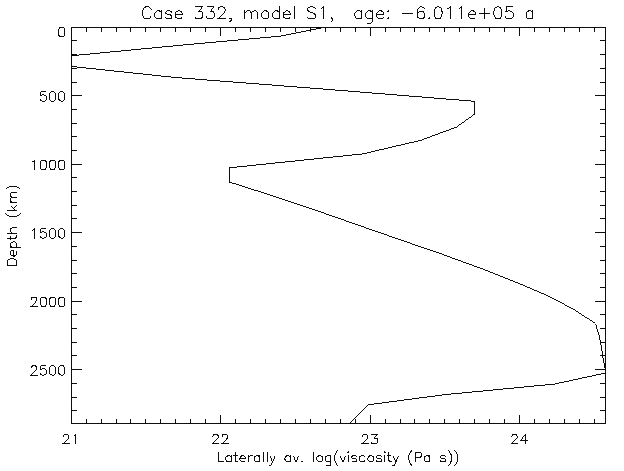The Moho
© Charles ChandlerThe Mohorovičić Discontinuity is the boundary between the Earth's crust and the mantle. It lies at an average of 35 km below the continental surface, and an average of 6 km beneath the ocean floor. (See Figure 1.) It was detected in seismograms from shallow-focus earthquakes, which showed two sets of P-waves and S-waves, one that followed a direct path near the Earth's surface, and the other that was refracted by a high-velocity medium.1:122 Immediately above the Moho, the velocities of the P-waves are like those through granite or basalt (6.7~7.2 km/s), and below they are similar to those of peridotitic or dunitic (7.6~8.6 km/s).2 The differences in velocities above and below the Moho correspond to the differences in density. Hence the lighter granite and basalt floats on top of the heavier mantle.There is also a lateral chemical differentiation in the crust, from continental granite to oceanic basalt. Since the granite occurs in clumps (i.e., continents), it extends far deeper than the oceanic crust, and thus floats on top of the mantle higher than the oceanic crust, for the same reason that the top of a large iceberg is higher than a small one.While the oceanic crust is similar to the composition of the mantle, the continental granite is different enough to beg the question of what allowed the differentiation. One possibility is that the granite was the donation from the Late Heavy Bombardment, as mentioned in the section on Remelted Crusts.The depth of the Moho changes only very gradually. Some researchers consider this to be very uncharacteristic of lithospheric chemical differentiation, with its highly irregular boundaries.3:77 (See Figure 2.) But this doesn't change the fact that there is a sudden shift in characteristics in the Moho, and gross differences between the matter above and below the Moho, including a distinct difference in density. So the present thesis takes all of this to signify a pressure-based chemical boundary (not a difference in composition).Figure 2. Detail of wave transmission speeds under the Mariana Islands, courtesy of the Geological Society of America.
© Suyehiro et al. (2007)Then comes the question of why the boundary between the mantle and the crust would be hotter. The temperature does not simply increase steadily with depth, nor do the isotherms follow the expectations of there being an internal heat source, and where the isotherms would be dictated by the thermal conductivity and diffusivity of crustal chemicals. Rather, the temperature increases steadily with depth, at roughly 0.02 K/m,4 until it spikes in the Moho at over 900 K, and then it drops back down to what it was just above the Moho. So there is no mistaking that there is a heat source in the Moho, and there is good reason to believe that this occurs at a chemical boundary.Extreme pressure physics is a young discipline, but recently, atomic theory (including quantum mechanics), and laboratory experiments (especially nuclear fusion research), have converged on a general paradigm. At extreme pressure, electrons are expelled by electron degeneracy pressure (EDP), leaving positive ions behind.5 This produces current-free double-layers. But the absence of currents in these CFDLs is predicated on the consistency of the pressure. If the pressure relaxes, EDP no longer forcibly ionizes the matter, and charges can recombine, driving an electric current. Similarly, if the pressure increases, electrons are expelled from neutral matter, again driving a current. Thus the CFDLs are not entirely current-free if the pressure fluctuates — there will be a current between the matter at the previous ionization boundary, to the location of the new boundary.What could cause the pressure to change inside the Earth?Twice a day, the crust is raised and lowered by tidal forces. When it is raised, the pressure at depth relaxes, enabling electrons to flow downward into matter that is no longer being forcibly ionized by EDP. When the tidal force relaxes, pressure at depth is restored, and electrons are expelled. With two ebbs and two floods per day, that's four surges of electric current per day. Ohmic heating is then the source of the temperature spike in the Moho. And since we know that the pressure is sufficient for ionization, the Moho is best characterized as a superconducting, supercritical, frictionless fluid.It should also be noted that when the Moho originally got established as a region of intense vertical electric currents (early in the formation of the Earth), it naturally became the preferred conduit for lateral currents as well. Thus when the pressure increases at low tide, and electrons are expelled from the mantle, they are not likely to flow against the high resistance of the solid rock in the crust — rather, they will encounter much less resistance flowing laterally through the Moho. To what destination? While electrons are being expelled in two quadrants of the Earth (which are at low tide), electron uptake is occurring in the other two quadrants (which are at high tide). Thus the four electrical poles are connected by the superconducting fluid in the Moho, and the bulk of the current will be lateral instead of vertical.So why would this boundary occur at chemical differentiation, instead of along an isobar, if it is pressure-dependent? Where there is no chemical differentiation, thresholds for EDP do occur at isobars — when the pressure becomes sufficient for the next degree of ionization, the next threshold is crossed. But ionization potentials vary widely from one chemical to the next, and are far and away the most powerful force.Within this framework, the general characteristics of the crust and the mantle are easy to assimilate. The crust is rigid, while the mantle is plastic. The rigidity of solid rock is easy to understand, due to the strength of its crystal lattice. Under increasing pressure, it fractures. But under extreme pressure, it undergoes plastic deformation, "flowing" as if it was a liquid, instead of fracturing. This is not due just to pressure, but rather, to its implication — the expulsion of electrons by the Pauli Exclusion Principle weakens the crystal lattice, enabling plasticity. Many substances undergo chemical transformations under extreme pressure, such as the conversion of graphite to diamonds. So the crystal lattice gets destroyed at depth and then reformed, perhaps in a different configuration, if the rock is somehow thrust above the Moho.More importantly, electric currents in the Moho might be the primary near-surface heat source. Since direct measurements reveal increases in temperature with depth, it has always been assumed that they continue to increase all of the way to the core, and that all of the Earth's heat is simply left over from the original aggregation. Yet the wave transmission anomalies inside the Earth do not indicate a steady increase in temperature with depth, or even a step-like increase (as in Figure 4). Rather, they indicate heat sources at specific depths, with cooler temperatures above and below (as in Figure 5).
References
1. McLeish, A. (1992): Geological Science. Nelson Thornes ⇧
2. Badescu, V.; Cathcart, R. B.; Schuiling, R. D. (ed.) (2006): Macro-Engineering - A Challenge for the Future. Springer ⇧
3. Howell, B. F., Jr. (1990): An Introduction to Seismological Research: History and Development. Cambridge University Press ⇧
4. E. McDuff, R.; Heath, G. R. (2014): Heat Conduction in the Oceanic Crust. washington.edu ⇧
5. Chandler, C. (2019): CFDLs Caused by EDP. QDL, 12483 ⇧
Bibliography
Suyehiro, K. et al. (2007): Crustal structure and evolution of the Mariana intra-oceanic island arc. Geology, 35 (3): 203-206















